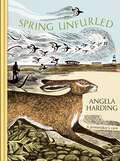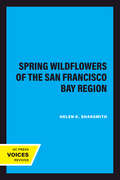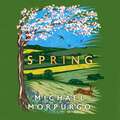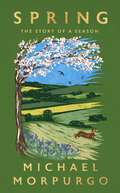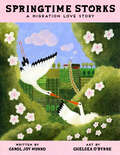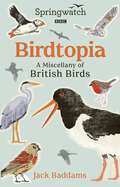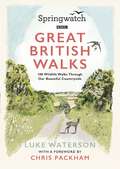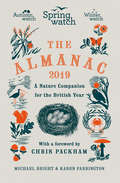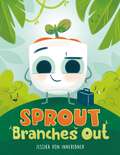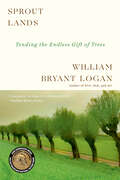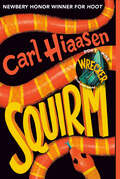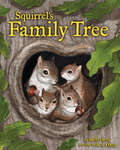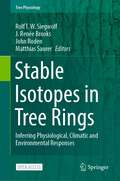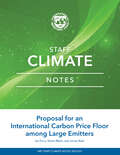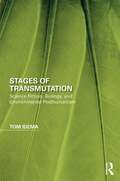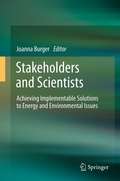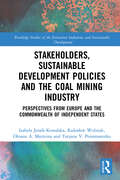- Table View
- List View
Spring Unfurled: part of a beautiful new series from beloved illustrator and print-maker Angela Harding
by Angela Harding'Spring, at all its stages, has an energy that engages us with the outside world.'Spring Unfurled is the first in a stunning seasonal quartet from beloved printmaker and illustrator Angela Harding.'Seasonal change has always been a great inspiration for my artwork. I love the changing light that brings new colours and smells. The seasons are nature's clock, bringing birds from distant shores to nest and breed in our gardens. So it is hard to say exactly when one season stops and the other begins; the changes are not necessarily gradual but come in fits and starts. Seasons have no regard for the official times written down in a calendar. Spring, more than any other of the seasons, is like this.'This pocket-sized series takes readers on a journey through the seasons, reflecting Angela's view as the nature around her transforms and evolves over the months. Taking in landscapes across the UK, from views from her home studio in Rutland to the Scottish wilderness, via the low-lying marshlands of Suffolk and the windswept hills of Yorkshire, the beautiful illustrations and evocative imagery of the prose make this the perfect book for nature lovers and art lovers everywhere.Featuring Angela's most beloved prints, alongside Angela's observations and inspirations, Spring Unfurled, Summer's Hum, Falling into Autumn and Winter's Song are a joyful celebration of nature and wildlife across the UK at all times of year.
Spring Unfurled: the beautiful new book from beloved illustrator and print-maker Angela Harding
by Angela Harding'Spring, at all its stages, has an energy that engages us with the outside world.'Spring Unfurled is the first in a stunning seasonal quartet from beloved printmaker and illustrator Angela Harding.'Seasonal change has always been a great inspiration for my artwork. I love the changing light that brings new colours and smells. The seasons are nature's clock, bringing birds from distant shores to nest and breed in our gardens. So it is hard to say exactly when one season stops and the other begins; the changes are not necessarily gradual but come in fits and starts. Seasons have no regard for the official times written down in a calendar. Spring, more than any other of the seasons, is like this.'This pocket-sized series takes readers on a journey through the seasons, reflecting Angela's view as the nature around her transforms and evolves over the months. Taking in landscapes across the UK, from views from her home studio in Rutland to the Scottish wilderness, via the low-lying marshlands of Suffolk and the windswept hills of Yorkshire, the beautiful illustrations and evocative imagery of the prose make this the perfect book for nature lovers and art lovers everywhere.Featuring Angela's most beloved prints, alongside Angela's observations and inspirations, Spring Unfurled, Summer's Hum, Falling into Autumn and Winter's Song are a joyful celebration of nature and wildlife across the UK at all times of year.
Spring Wildflowers of the San Francisco Bay Region (California Natural History Guides #11)
by Helen K. SharsmithThis title is part of UC Press's Voices Revived program, which commemorates University of California Press’s mission to seek out and cultivate the brightest minds and give them voice, reach, and impact. Drawing on a backlist dating to 1893, Voices Revived makes high-quality, peer-reviewed scholarship accessible once again using print-on-demand technology. This title was originally published in 1965.
Spring into Summer!/Fall into Winter! (Pictureback(R))
by Joe Mathieu Aristides Ruiz Tish RabeFans of the hit PBS Kids' TV show The Cat in the Hat Knows a Lot About That! have cause to celebrate--all year round! In this ebook featuring two books in one, the Cat and Co. go, go, go, GO on an adventure to the magical Garden of Seasons, where they are able to see how the change in temperature affects plants and animals. Among the new friends they meet is a snowshoe hare whose brown fur turns white to help him hide in the snow, a tadpole who turns into a frog and then hibernates during the winter, and a Canadian goose gosling who grows up and migrates south in the fall. All in all, this is a perfect introduction to the yearly cycle that can be enjoyed any time of the year!
Spring's Miracles (An Indigenous Celebration of Nature)
by Kaitlin B. CurticeA vibrantly illustrated children's book about an Indigenous girl who discovers the miracles that blossom each spring and learns how Creator's gift of courage can transform the way we see the world and ourselves.It&’s time to welcome a new season, and this spring is going to be extra special. Dani, a Potawatomi girl, and her family prepare to celebrate the new year, which the Potawatomi and other Anishinaabe people observe at the beginning of spring with a camping and climbing trip. Dani is excited for the adventure, but also nervous. The rocks are so big. Will she make it to the top of her climb? As Dani explores the awakening woods and makes memories with her family, she learns to draw on the courage Creator gives while finding inspiration in the miraculous new life Mother Earth brings forth each spring.
Spring: The Story of a Season
by Michael MorpurgoMICHAEL MORPURGO'S FIRST BOOK OF ADULT NON-FICTION IN FORTY YEARS.A GUARDIAN AND TIMES BEST BOOK OF 2025'Uplifting and enchanting. A celebration of life by our master story-teller.' JOANNA LUMLEY'Spring is a delight. His love and knowledge of the countryside are profound. We are all the richer for what he sees.' PHILIP PULLMAN'Full of vibrant colour and most of all, heart and soul.' CLARE BALDINGAnd there, as I struggle to open the gate, I happen to glance down and see it. Frog spawn! Clumps of it, floating like grey slimy sponges on the surface of the puddle. I crouch down to be close to it, to the beginning of new life.Michael Morpurgo has lived on a farm deep in rural Devon for more than forty years. In Spring, he observes the season unfold around him, as fragile new shoots emerge, buds turn to blossom and grey skies give way to blue. As the natural world shakes off a long winter, Michael watches lambs being born on the farm, delights in a fanfare of bluebells in the woods, and sings to the birds, dressed in his wellies and dressing gown. He shares small moments of joy found in the back garden, as well as more dramatic encounters with sparrowhawks, hares and otters. With new poems and reminiscences about childhood and springs gone by, this is an enchanting memoir of a season from one of the world's best-loved authors.
Spring: The Story of a Season
by Michael MorpurgoMICHAEL MORPURGO'S FIRST BOOK OF ADULT NON-FICTION IN FORTY YEARS.A GUARDIAN AND TIMES BEST BOOK OF 2025'Uplifting and enchanting. A celebration of life by our master story-teller.' JOANNA LUMLEY'Spring is a delight. His love and knowledge of the countryside are profound. We are all the richer for what he sees.' PHILIP PULLMAN'Full of vibrant colour and most of all, heart and soul.' CLARE BALDINGAnd there, as I struggle to open the gate, I happen to glance down and see it. Frog spawn! Clumps of it, floating like grey slimy sponges on the surface of the puddle. I crouch down to be close to it, to the beginning of new life.Michael Morpurgo has lived on a farm deep in rural Devon for more than forty years. In Spring, he observes the season unfold around him, as fragile new shoots emerge, buds turn to blossom and grey skies give way to blue. As the natural world shakes off a long winter, Michael watches lambs being born on the farm, delights in a fanfare of bluebells in the woods, and sings to the birds, dressed in his wellies and dressing gown. He shares small moments of joy found in the back garden, as well as more dramatic encounters with sparrowhawks, hares and otters. With new poems and reminiscences about childhood and springs gone by, this is an enchanting memoir of a season from one of the world's best-loved authors.
Spring: The Story of a Season
by Michael MorpurgoMICHAEL MORPURGO'S FIRST BOOK OF ADULT NON-FICTION IN FORTY YEARS.A GUARDIAN AND TIMES BEST BOOK OF 2025'Uplifting and enchanting. A celebration of life by our master story-teller.' JOANNA LUMLEY'Spring is a delight. His love and knowledge of the countryside are profound. We are all the richer for what he sees.' PHILIP PULLMAN'Full of vibrant colour and most of all, heart and soul.' CLARE BALDINGAnd there, as I struggle to open the gate, I happen to glance down and see it. Frog spawn! Clumps of it, floating like grey slimy sponges on the surface of the puddle. I crouch down to be close to it, to the beginning of new life.Michael Morpurgo has lived on a farm deep in rural Devon for more than forty years. In Spring, he observes the season unfold around him, as fragile new shoots emerge, buds turn to blossom and grey skies give way to blue. As the natural world shakes off a long winter, Michael watches lambs being born on the farm, delights in a fanfare of bluebells in the woods, and sings to the birds, dressed in his wellies and dressing gown. He shares small moments of joy found in the back garden, as well as more dramatic encounters with sparrowhawks, hares and otters. With new poems and reminiscences about childhood and springs gone by, this is an enchanting memoir of a season from one of the world's best-loved authors.
Springtime Storks: A Migration Love Story
by Carol Joy MunroBased on the true story of two storks whose dedication to each other captured the world&’s attention, this soaring tale is a heartfelt call to protect the routes of migratory birds.★ School Library JournalKaterina and Luka, two majestic, mated white storks, are in flight when Katerina is shot down by a hunter and left severely injured. Nearby, a man and his granddaughter see the bird fall from the sky and rush to her rescue. As they nurse Katerina back to health, Luka, who has been by her side night and day, feels the coming cold and knows he must migrate—even though it means leaving his beloved Katerina behind, to be cared for by the family who rescued her. When spring arrives, Katerina watches the sky, hoping that she might see Luka's familiar silhouette again . . . and he returns! Together, they raise a new brood, overcoming Katerina's flightlessness with ingenuity and devotion. Poetic and gorgeously illustrated, Springtime Storks is an ode to the resilience, dedication, and love between two migratory birds, while also delivering an urgent message of conservation.
Springwatch: Birdtopia
by Jack BaddamsDid you know that the word 'swansong' comes from an ancient belief that while swans were silent throughout their lives, they sang a beautiful song on their deathbed? Or that a group of skylarks is called an exultation?Over the years, Springwatch has brought us unforgettable moments featuring our feathered friends, from nest cams capturing hatchlings as they emerge from their eggs to red kites soaring majestically in search of prey. Now, delve into the ultimate bird lover's companion, with expert tips on where to find British bird species and how to identify them, alongside avian folklore and favourite stories from the series.Arranged by bird family, Birdtopia includes explanations behind unusual collective nouns for birds - an unkindness of ravens may stem from the nineteenth-century belief that these birds turned their young out of the nest to fend for themselves - descriptions of bird calls, the reasons why birds create beautiful murmuration displays and the top places to spot them.Written by Springwatch naturalist and TikTok and Instagram’s ‘bird guy’ Jack Baddams and beautifully illustrated with line drawings, Birdtopia is the perfect gift for any bird lover.And the best thing about it all? We’re not talking about birds in some far off land, on the other side of the world. These are the ones we can see whenever we step outside our doors. They’re right there, for everyone. Get out and enjoy them!
Springwatch: Great British Walks
by Luke Waterson100 wildlife walks through our beautiful British countryside. The beautiful countryside and intimate wildlife stories explored in Springwatch have inspired viewers to get outside and reconnect with the natural world for almost 20 years. Now this new practical compendium will help you go further, bringing together the most scenic walks and diverse wildlife from around Britain. Covering every region in the UK, it includes a range of easy strolls and more challenging hikes for every level of walker, each featuring wildlife unique to the area: from white-tailed eagles on the Isle of Mull and red squirrels in Northumberland, to grey seals in Devon, bottlenose dolphins along the Welsh coast and sparrowhawks in Northern Ireland. Detailed descriptions of routes, specially-commissioned maps and easy-to-follow practical information ensure you have everything you need to set out on these walks yourself, with tips on spotting flora and fauna, with a key species selected for each walk across the country.With a foreword by Chris Packham, and beautiful line art throughout, whether you feel like wandering through a bluebell wood or enjoying the sea breeze on a dramatic coastal path, Springwatch: Great British Walks has something for every season - and it's all just outside your door.
Springwatch: The 2019 Almanac
by Michael Bright Karen Farrington‘Beautiful, fun, a great book… the best book ever written!’ - Chris Evans‘It is a brilliant book, a toolkit, packed full of information – even I learnt a few new things!’ - Chris Packham Explore the world outside your window.For 13 years the BBC's Springwatch and its sister programmes, Autumnwatch and Winterwatch, have been bringing the best of Britain’s wildlife into our homes. Now Springwatch: The 2019 Almanac offers the perfect guide for anyone looking to get out and explore the wonders of nature just outside their back door. Taking you month by month through the coming year, the almanac combines compelling stories with practical guidance that will inspire anyone to start exploring. It has all the information you need to discover the natural wonders around you, from how to identify animal tracks and bird nests to the best time to witness starling murmurations and mayflies hatching. Complete with monthly daylight and rainfall charts and beautifully illustrated with black and white line drawings, The Springwatch Almanac is the ideal companion for every nature lover.
Sprout Branches Out
by Jessika von InnerebnerDiscover the unbe-leaf-ably adorable story of a young plant with mulch to learn in this feel-good tale perfect for fans of The Bad Seed and Grumpy Monkey.Sprout the plant lives on a small porch, in a little town. She’s only been able to grow two leaves and knows exactly why. Home is just not enough for her – she needs to venture out to the wild woods, the wise forest, and the lush jungle to find what she needs to thrive.But once she’s out in the world, Sprout quickly learns that what she really needs may not be what she thought at all . . . Meet a budding new picture book character with roots in this hilarious and heartfelt adventure about growing up, taking risks, and finding home again.
Sprout Lands: Tending The Everlasting Gift Of Trees
by William Bryant LoganWinner of the 2021 John Burroughs Medal for Distinguished Natural History Writing "This deeply nourishing book invites us to reclaim reciprocity with the living world." —Robin Wall Kimmerer, author of Braiding Sweetgrass Once, farmers and rural people knew how to prune hazel to foster abundance: both of edible nuts and of straight, strong, flexible rods for bridges, walls, and baskets. Townspeople felled their beeches to make charcoal to fuel ironworks. Shipwrights shaped oaks to make hulls. No place could prosper without its inhabitants knowing how to cut their trees so they would sprout again. Pruning the trees didn’t destroy them. Rather, it created the healthiest, most sustainable and diverse woodlands that we have ever known. Arborist William Bryant Logan offers us both practical knowledge about how to live with trees to mutual benefit and hope that humans may again learn what the persistence and generosity of trees can teach. He recovers the lost tradition that sustained human life and culture for ten millennia.
Spy Secrets That Can Save Your Life: A Former CIA Officer Reveals Safety and Survival Techniques to Keep You and Your Family Protected
by Jason HansonThe New York Times bestseller that reveals the safety, security, and survival techniques that 99% of Americans don&’t know—but shouldWhen Jason Hanson joined the CIA in 2003, he never imagined that the same tactics he used as a CIA officer for counter intelligence, surveillance, and protecting agency personnel would prove to be essential in every day civilian life. In addition to escaping handcuffs, picking locks, and spotting when someone is telling a lie, he can improvise a self-defense weapon, pack a perfect emergency kit, and disappear off the grid if necessary. He has also honed his &“positive awareness&”—a heightened sense of his surroundings that allows him to spot suspicious and potentially dangerous behavior—on the street, in a taxi, at the airport, when dining out, or in any other situation. In his engaging and empowering book Spy Secrets That Can Save Your Life, Jason shares this know-how with readers, revealing how to: • prevent home invasions, carjackings, muggings, and other violent crimes • run counter-surveillance and avoid becoming a soft target • recognize common scams at home and abroad • become a human lie detector in any setting, including business negotiations • gain peace of mind by being prepared for anything instead of uninformed or afraid With the skill of a trained operative and the relatability of a suburban dad, Jason Hanson brings his top-level training to everyday Americans in this must-have guide to staying safe in an increasingly dangerous world.
Squids (Nature's Children)
by James KinchenIntroduces the physical features, habits and natural environment of squids and their relatives.
Squirm
by Carl HiaasenA wildly entertaining adventure involving snakes, grizzlies, a menacing drone, a missing father, and the kid determined to find him. In classic Hiaasen fashion, the animals here are wild, and the people are wilder! Some facts about Billy Dickens: * He once saw a biker swerve across the road in order to run over a snake. * Later, that motorcycle somehow ended up at the bottom of a canal. * Billy isn't the type to let things go. Some facts about Billy's family: * They've lived in six different Florida towns because Billy's mom insists on getting a house near a bald eagle nest. * Billy's dad left when he was four and is a total mystery. * Billy has just found his dad's address--in Montana. This summer, Billy will fly across the country, hike a mountain, float a river, dodge a grizzly bear, shoot down a spy drone, save a neighbor's cat, save an endangered panther, and then try to save his own father. "A fun romp that will keep readers hooked." —The New York Times
Squirrel's Family Tree
by Beth FerryNew York Times bestselling author Beth Ferry and illustrator A. N. Kang explore the secret lives of squirrels and oak trees in a charming and unforgettable read-aloud story.Squirrel gathers acorn seeds, sturdy little oak nut seeds. Anticipating future needs, she gathers acorn seeds. What makes an oak tree an oak tree and what makes a squirrel a squirrel? In Squirrel's Family Tree, things aren't always what they seem. As squirrel searches for, finds, and hides her acorn treasures beneath the shadows of the great oak trees in the forest, little does she know the role she plays in creating the very environment she forages in.With masterful illustrations by Papillon illustrator A. N. Kang and delightful, sweet rhymes by New York Times bestseller Beth Ferry, this read-aloud masterpiece about the beauty of nature and the intricate relationships that make it flourish is sure to become an instant classic.
Squirrels: The Animal Answer Guide (The Animal Answer Guides: Q&A for the Curious Naturalist)
by Richard W. Thorington Jr. Katie E. FerrellDid you know that a groundhog is really a type of squirrel? That squirrels control their body temperature with their tails? That most squirrels have yellow-tinted eye lenses that work like sunglasses to reduce glare? That tree squirrels can turn their hind feet completely around when climbing down a tree head-first? In Squirrels: The Animal Answer Guide, Richard W. Thorington Jr. and Katie Ferrell unveil the fascinating world of one of the "most watched" mammals on the planet. The diversity of squirrels is astounding. There are 278 species that inhabit all continents except Antarctica and Australia—varying in size from the lumbering 18-pound gray marmot to the graceful pygmy flying squirrel that is smaller than most mice. In many parts of the world they readily share human habitats, joining us for lunch in a city park, raiding our bird feeders, and sneaking into college dorm rooms through open windows. Reviled as pests or loved as an endearing amusement, squirrels have played important roles in trade, literature, and mythology. Thorington and Ferrell cover every aspect of this diverse animal family, from the first squirrels of 36 million years ago to the present day. With over one hundred photographs and an intuitive question-and-answer format, this authoritative and engaging guide sheds light on a common mammal that is anything but commonplace.
Stable Isotopes in Tree Rings: Inferring Physiological, Climatic and Environmental Responses (Tree Physiology #8)
by Rolf T. W. Siegwolf J. Renée Brooks John Roden Matthias SaurerThis Open Access volume highlights how tree ring stable isotopes have been used to address a range of environmental issues from paleoclimatology to forest management, and anthropogenic impacts on forest growth. It will further evaluate weaknesses and strengths of isotope applications in tree rings. In contrast to older tree ring studies, which predominantly applied a pure statistical approach this book will focus on physiological mechanisms that influence isotopic signals and reflect environmental impacts. Focusing on connections between physiological responses and drivers of isotope variation will also clarify why environmental impacts are not linearly reflected in isotope ratios and tree ring widths. This volume will be of interest to any researcher and educator who uses tree rings (and other organic matter proxies) to reconstruct paleoclimate as well as to understand contemporary functional processes and anthropogenic influences on native ecosystems. The use of stable isotopes in biogeochemical studies has expanded greatly in recent years, making this volume a valuable resource to a growing and vibrant community of researchers.
Stages of Transmutation: Science Fiction, Biology, and Environmental Posthumanism (Perspectives on the Non-Human in Literature and Culture)
by Tom IdemaStages of Transmutation: Science Fiction, Biology, and Environmental Posthumanism develops the theoretical perspective of environmental posthumanism through analyses of acclaimed science fiction novels by Greg Bear, Octavia Butler, Kim Stanley Robinson, and Jeff VanderMeer, in which the human species suddenly transforms in response to new or changing environments. Narrating dramatic ecological events of human-to-nonhuman encounter, invasion, and transmutation, these novels allow the reader to understand the planet as an unstable stage for evolution and the human body as a home for bacteria and viruses. Idema argues that by drawing tension from biological theories of interaction and emergence (e.g. symbiogenesis, epigenetics), these works unsettle conventional relations among characters, technologies, story-worlds, and emplotment, refiguring the psychosocial work of the novel as always already biophysical. Problematizing a desire to compartmentalize and control life as the property of human subjects, these novels imagine life as an environmentally mediated, staged event that enlists human and nonhuman actors. Idema demonstrates how literary narratives of transmutation render biological lessons of environmental instability and ecological interdependence both meaningful and urgent—a vital task in a time of mass extinction, hyperpollution, and climate change. This volume is an important intervention for scholars of the environmental humanities, posthumanism, literature and science, and science and technology studies.
Stairway to Heaven: Poems
by Alison DemingA new collection from a poet who "writes with scrupulous and merciful passion about every kind of relatedness--family, place, politics, and wildlife" (W. S. Piero)In her fifth book of poems, Stairway to Heaven, Alison Hawthorne Deming explores dimensions of grief and renewal after losing her brother and mother. Grounded in her communion with nature and place, she finds even in Death Valley, that most stark of landscapes, a spirit of inventiveness that animates the ground we walk on. From the cave art of Chauvet to the futuristic habitat of Biosphere 2, that inventiveness becomes consolation for losses in family and nature, a means to build again a sense of self and world in the face of devastating loss.From the Trade Paperback edition.
Stakeholders and Scientists
by Joanna BurgerNation and the World must move forward with development of a range of energy sources and savings, all with attendant environmental problems. Solving these problems, and those remaining from past energy-related activities, will require iteration, inclusion, and collaboration with a wide range of stakeholders, including U.S., State and local governmental agencies, Tribal Nations, scientists, environmentalists, public policy makers, and the general public.
Stakeholders, Sustainable Development Policies and the Coal Mining Industry: Perspectives from Europe and the Commonwealth of Independent States (Routledge Studies of the Extractive Industries and Sustainable Development)
by Izabela Jonek-Kowalska Radosław Wolniak Oksana A. Marinina Tatyana V. PonomarenkoThis book identifies the impact of internal and external stakeholders on the implementation of sustainable development policies in the coal mining sector in Europe and the Commonwealth of Independent States. The book assesses what activities and conditions need to be improved so that sustainable development policies can be more effectively and efficiently implemented. With a specific focus on the hard coal and lignite mining sectors, it examines a broad range of case studies from Eastern European countries and the Commonwealth of Independent States, including Russia, Ukraine, Poland, Kazakhstan, Germany, Spain, France and the United Kingdom, among many more. Beginning with an introduction to sustainable development and stakeholder theory, Part II then examines internal stakeholders, including owners, managers, employees and trade unions. Part III examines external stakeholders, touching upon those directly related to the mining industry, such as customers and mining enterprises, and those not directly associated such as local and regional communities and environmental organisations. The book concludes by proposing a model approach to the management of stakeholders involved in mining enterprises, focusing on improving the process of implementing sustainable development in the mining sector and strengthening the effects of this process. This book will be of great interest to students and scholars of the extractive industries, natural resource management and policy and sustainable development.
